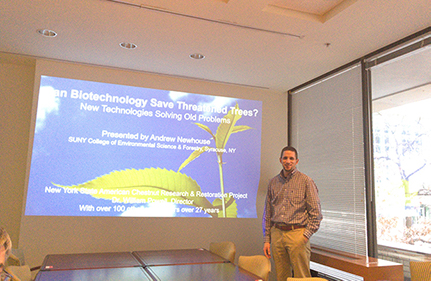Can Biotechnology Save Threatened Trees?
-

February 14, 2018
2:00 pm - 3:30 pmWashington, DC, USA
Mr. Andrew Newhouse of the American Chestnut Research & Restoration Project (SUNY-ESF) visited the Agriculture & Food Systems Institute to present a seminar on using genetic engineering to allow coexistence of transgenic American chestnut trees with the blight that nearly drove the species extinct. Mr. Newhouse described research that has encompassed genetic transformation and molecular analyses of transgenic, blight resistant chestnut, blight screening and ecological field tests.
Before the turn of the century, the eastern half of the United States was dominated by the American chestnut. Because it could grow rapidly and attain huge sizes, the tree was often the outstanding visual feature in both urban and rural landscapes. All of this began to change at or slightly before the turn of the century with the introduction of Cryphonectria parasitica, the causal agent of chestnut blight. This disease reduced the American chestnut from its position as the dominant tree species in the eastern forest to little more than an early-succession-stage shrub.
Andrew Newhouse has been working on projects that overlap the fields of ecology and molecular biology for more than 15 years. During the past 11 years, he has worked with the American Chestnut Research & Restoration Project, at the State University of New York’s College of Environmental Science & Forestry. This project has developed transgenic American chestnut trees that are tolerant of chestnut blight, a disease that nearly extirpated mature trees from their native range in the eastern USA. Andrew has worked on a variety of aspects of this project, from genetic transformation and molecular analyses to blight screening and ecological field tests. Most recently, he has been preparing for the US federal regulatory review process, a set of rigorous evaluations required before the trees can be distributed or used for restoration.
